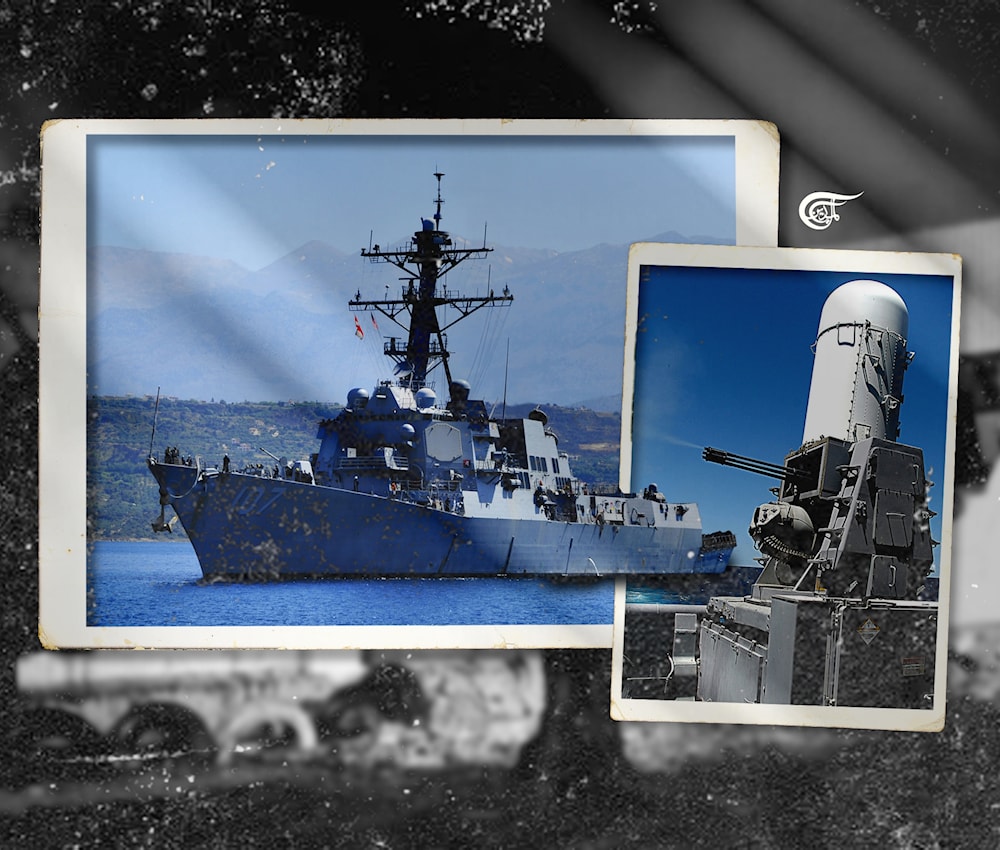Testing Western capabilities in the Red Sea against Yemen
Is the assumption that US systems failed to intercept the missile the result of advanced technology possessed by the Yemeni Armed Forces, or is it just a coincidence?
-

The automated Phalanx system is equipped with computer-controlled gatling guns that can fire up to 4,500 rounds of 20mm cartridges per minute and engage targets at extremely close range. (Al Mayadeen English; Illustrated by Zeinab El-Hajj)
The official page of the US Central Command, CENTCOM, reported in a statement on platform X on January 30, 2024, that at 11:30 pm (Sanaa time), Destroyer USS Gravely (DDG 107) shot down an anti-ship cruise missile launched by the Ansar Allah from the areas they control in Yemen toward the Red Sea. No injuries were reported.
Later, information emerged that the destroyer in question, and other US and Western vessels, failed to intercept the missile in the early stages of launch. It had to use an advanced weapons system called the Phalanx, a Close-In Weapon System (CIWS), known as the “last line of defense”, “against what US officials said was a cruise missile that got as close as 1 mile to the ship and therefore seconds from impact.”
So, what is this weapon and why was it used then? Although there are advanced missile systems carried by American destroyers to protect naval vessels in case of exposure to winged missiles, similar to cruise missiles and Tomahawks, at long distances from the target estimated at more than seven miles (a nautical mile is 1852 meters).
Is the assumption that US systems failed to intercept the missile the result of advanced technology possessed by the Yemeni Armed Forces, or is it just a coincidence? This raises a question about the feasibility of the American approach in its entirety in confronting the military operations carried out by the Ansar Allah movement in support of Gaza and in defense of the Palestinian people.
What about the repercussions of the potential success of the Yemeni Armed Forces in striking an American military target such as the Gravely. Is this Western presence in the Red Sea really a force majeure that cannot be tackled, or is it encountering difficulties, problems and gaps that could be fatal if they can be exploited appropriately? It seems that the Yemeni forces and the Yemeni Army have been able to significantly improve their capabilities since the Ansar Allah movement took power in Sanaa, where it worked in all military, and civilian, fields on upgrading and implementing programs to acquire military capabilities, especially naval ones, as "the Houthis now have a large military arsenal of three of the most powerful anti-ship ballistic missiles in the world."
What is the Phalanx System?
The automated Phalanx system is equipped with computer-controlled gatling guns that can fire up to 4,500 rounds of 20mm cartridges per minute (in its latest and most powerful type) and engage projectiles or other targets at extremely close range. It is also equipped with an electro-optical system and infrared cameras. The Phalanx is a radar-guided gun that can defeat anti-ship missiles and other close-range threats on land and at sea. Since 1980, it has been installed on all US Navy ships. It is also used by at least 24 US-allied countries, according to Raytheon, the American company that manufactured it.
Incident analysis
Since October 19, 2024, American destroyers with Arleigh Burke-class defense systems, like the Aegis Combat System that intercepts guided missiles, have managed to destroy 68 cruise missiles and 19 anti-ship missiles (a mixture of ballistic and cruise) launched by Yemeni forces in the Red Sea, and the destroyer USS Carny is alone responsible for shooting down 38 projectiles. The USS Gravely destroyer, in addition to its Aegis system, is also equipped with the Phalanx system, which dealt with the threat and shot the projectiles down.
But with all the advanced Aegis radars that are qualified to deal with 100 targets launched in parallel from different sides of the destroyer, which is equipped with ray sensors, Standard SM-2, Standard SM-6 missiles and Evolved Sea Sparrow, “While there is no damage or loss of life and the missile was intercepted, the engagement was not ideal.” This was a serious development. “Given the character of this incident, it is probable that tactics such as decoys and countermeasures, encompassing both physical and electronic warfare strategies, were utilized. But it ultimately came down to the last line of defense. Evidently, the anti-air missile system and electronic countermeasures proved ineffective, leading to the deployment of the Phalanx system as a final recourse.”
American analysts who worked for several years in several US naval intelligence services put possibilities for what happened with the Gravely. Konstantin Toropin, a press correspondent at the Pentagon, says, “Most of the defensive shots made by naval ships were made using missiles such as the SM-2 naval missiles, which have a range of about 90 miles. It is not clear whether the Gravely was forced to engage the missile at a significantly closer range because it was not detected in time, the missiles were launched but failed to shoot down the threat, or the Houthis are using a new capability.”
According to Business Insider, “the air defense radars and missile defense systems on the Arleigh Burke-class destroyer did not detect the Houthi missile,” noting that the SM-2 and SM-3 interceptor missiles are considered among the most modern interceptor missiles in the world, which have a speed of about Mach 3 and can hit targets at a distance of 166.7 kilometers and at an altitude ranging from 150 meters to 15 kilometers.
While the news confirmed that the Gravely destroyed was targeted by a Yemeni ballistic missile and that the Phalanx system’s response to the threat was the first of its kind in the ongoing conflict in the Red Sea, according to CNN, what was also revealed was that a British battleship was also forced to use its “last line of defense” system (CIWS) when it dealt with a massive attack carried out by Yemeni forces on January 9, 2024, in which “the Royal Navy destroyer HMS Diamond shot down seven drones in a day, including one with its 30 mm gun. It was the Royal Navy’s first confirmed aerial kill with anti-aircraft guns since the Korean War. It is also the second time that a Houthi munition has come close enough to a coalition warship to be targeted with the ship's guns.”
Failure to confront
The other matter that we can monitor is the context of what could be considered a weakness in the American and Western military approach to confronting attacks by Yemeni forces, and the possibility of them being subjected to severe strikes as a result of technological or human failure. Naturally, this adds to the decline in military reputation and ability to deter, such as what American and Western military equipment has incurred, especially tanks in the Russian-Ukrainian war. There are also other similar incidents and operations, such as targeting the British warship destroyer HMS Diamond, and its replacement under the pretext of maintenance and supplying equipment.
Also, the failure of the American base, known as Tower 22 in north Jordan, to protect its soldiers, led to the killing of three members of the American military service by a drone, which the advanced protection systems installed at American bases in Syria and Iraq failed to detect and deal with, as “the periodic success achieved by militants in attacks may be unavoidable, given the sheer number of drones, missiles and projectiles fired at American forces and the fact that defenses cannot realistically be completely 100% effective.” said current and former US officials.
The leadership of the British Royal Navy revealed that the frigate HMS Richmond will replace its counterpart, HMS Diamond, whose commander, Peter Evans, said: “The situation in the region is fraught, and ships in the force are firing on a daily basis – we hand over the baton with our best wishes to the fantastic team in Richmond, who we know will do a great job.” He further added, “Having deployed at just five days’ notice, we’re used to quickly switching aim, and now our focus is on a short maintenance and ammunition resupply period before we get back to our mission in the Red Sea.”
The replaced destroyer successfully dealt with three separate attacks carried out by Yemeni forces. Royal Navy sailors shot nine drones out of the sky using the Sea Viper missile system. It is possible that the reason for its actual withdrawal was to resupply it with ammunition and to undergo maintenance, as stated by its commander, as a result of the possibility of it being hit by the remnants of the missile that threatened its safety, and from which the 30 mm “last line of defense” (CIWS) system saved it.
According to analyst Carl Schuster, a former US Navy captain, destroying a missile coming at a distance of one mile does not necessarily prevent warships from being hit with debris, and in the case of the destroyer Gravely, “the Houthi missile, traveling at about 600 miles per hour (965 kilometers per hour), was most likely about 4 seconds away from hitting the US warship when it was destroyed by what was likely 2 to 3 seconds.” He added: "Missiles do not evaporate when destroyed; they send out thousands of fragments and missile frame parts. The lighter parts decelerate quickly, but large chunks can fly up to 500 meters.” Schuster explained, “The closer the incoming missile is to the ship when destroyed, the more danger to the ship, with larger chunks able to penetrate unarmored parts of the hull and superstructure from about 200 meters.”
Schuster was talking about a subsonic cruise missile which was not intercepted by the destroyer's super-fast defenses, and “this did not happen for reasons that have not been revealed.” The same thing happened to the British destroyer due to its failure to intercept the Yemeni missile, when it used systems similar to Phalanx.
It is worth noting that the British Navy has plans entitled Sea Viper Evolution (SV-E) to modernize six Type 45 ships to complete the replacement and modernization of defense and missile systems by 2032, enabling them to confront the most advanced Yemeni ballistic missiles, “especially since the Royal Navy must currently rely on US Navy escorts to counter the increasing ballistic missile threat to its carrier strike group,”and “until the Sea Viper Evolution (SV-E) project is complete, Type 45 destroyers officially do not yet have Theatre Ballistic Missile Defense (TBMD) capability to counter this type of weapon employed by the Houthis.”
Conclusion
While there was a measure of reliance was on the continued strong Western military presence in the Red Sea to confront Yemen’s siege of Zionist navigation there, the rotation of naval vessels, destroyers, and aircraft carriers for a continuous and effective presence near Bab al-Mandab, the British government’s aspiration “to plug a gap in US deployments” in the Middle East, and the possibility of replacing the USS Dwight Eisenhower destroyer, which is scheduled to return to the United States soon, by its British counterpart, HMS Queen Elizabeth, technical and logistical problems have appeared in the British Royal Navy, as the latter canceled the Queen Elizabeth’s participation in a NATO exercise, which was considered crucial to readiness for any escalation of unrest in the Red Sea.
Divers discovered a major problem in the underwater propeller shaft of the destroyer during final checks, and websites specialized in military maritime affairs also published in detail the multiple problems and technical and structural difficulties the Royal Navy suffers from in the Red Sea in its approach to confronting the Yemeni escalation, whether by confronting missiles or by direct ground targeting.
The approaching of the American elections also impacts what is happening in the Red Sea, and also impacts the approach that must be formulated in the face of the growing Yemeni role, regardless of the temporary Zionist entity’s continuation of its aggression against the Palestinian people and Gaza, as it seems that the UK is encouraged by the increased presence in the region, driven by previous colonial delusions towards Yemen, which is what Sayyed Abdul-Malik al-Houthi warned against in his last speech, when he said: “The American and British battle with us is not for the sake of international navigation, but for the sake of Israeli navigation, and if the British have delusions of colonizing our country, then it is a psychological disease, its medicine and treatment is with us, and if the last dose for the British ship that burned from night to night is not enough, more doses can be administered.”
However, examining the data and observing the mobilized Western capabilities and the way they confront Yemeni actions, and most importantly, the fact that Yemen has a righteous cause for which it is fighting and for which it has formulated its own coherent and declared logic, all point to the presence of gaps and fear on the Western side, as the West fears being affected by Yemeni military capabilities, and is trying to adapt to this assumption.
British Colonel Stuart Crawford asserts, “These attacks and tit-for-tat responses are likely to continue until something more dramatic and dangerous happens. It may be that instead of a cessation of hostilities, we might look at some sort of balance with neither side upping the ante.” “I think that might be palatable to Western opinion, for the time being at least. However, let us consider, for a moment, what might have been the result of a more serious incident off the coast of Yemen. What if the Royal Air Force (RAF), for example, lost one of its Typhoon aircraft in a future raid on Houthi facilities? Or if the US Navy loses a warship due to the kind of attacks launched by unmanned surface ships that have been a clear success for the Ukrainians in the Black Sea? What next?”
Stuart believes that “strikes at a long distance will only lead to suppressing the threat, not eliminating it,” and he expects the political leadership of Western countries to “follow the common approach by continuing strike operations on Houthi positions, cutting off weapons supplies from Iran and others (through the presence of ground forces as he suggested) to the rebels, and using diplomatic channels and sanctions to persuade them to desist. All of this will take time, so I'm afraid we'd better get used to it.”
The issue with regard to the alien Western presence in the Red Sea region and its real interests in the stability of its countries, the prosperity of its trade and the strengthening of its interests with all countries of the world, including China, Russia, Iran, and others, is that it will not be able to be present all the time to protect the Zionist entity, with the high costs of securing its destroyers and battleships, which are worth millions of dollars in exchange for cheap Yemeni drones.
Time will exhaust this strange presence, as “A coalition of the willing led by the US is quite capable of reducing Houthi capacity of action for a time. Without sending in troops, the Houthis will not surrender; they can re-group and be resupplied by Iran, an enduring threat that cannot be eliminated. This could imply an expensive open-ended commitment, tying down limited naval resources for years that would exceed the effort already expended containing Iran in the Persian Gulf.”

 Nasser Al Housseini
Nasser Al Housseini
 14 Min Read
14 Min Read









